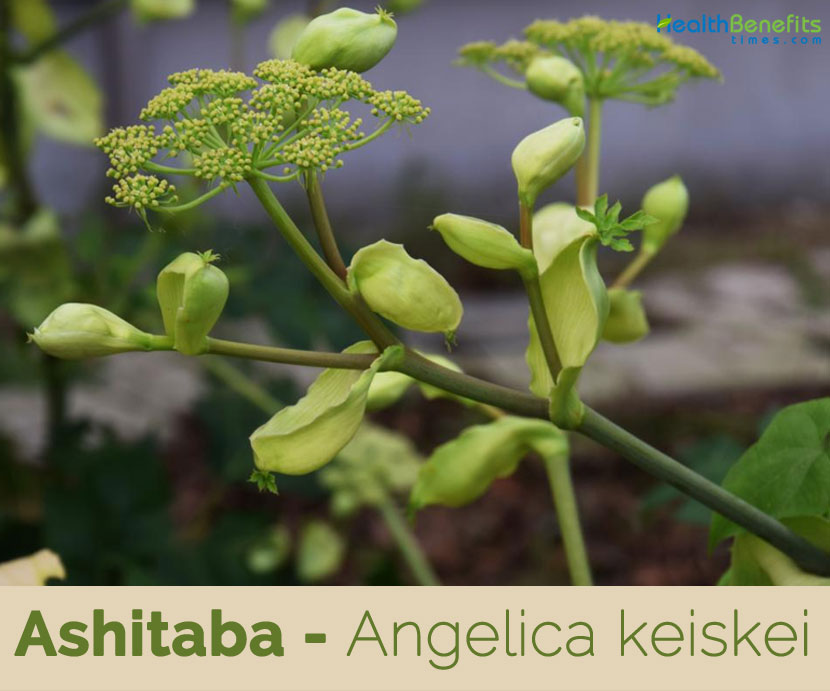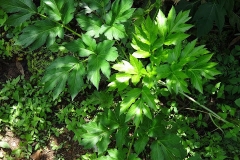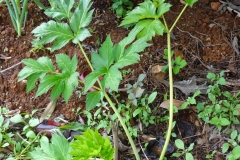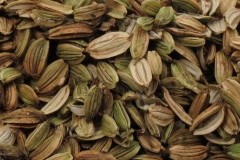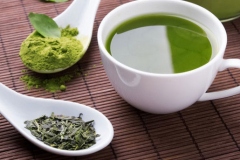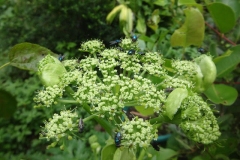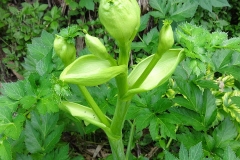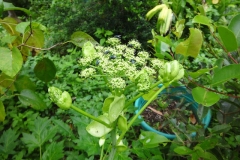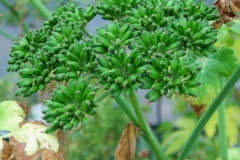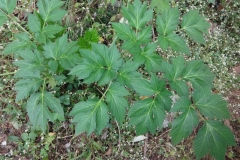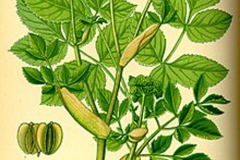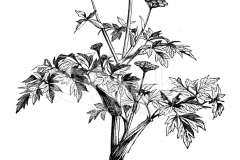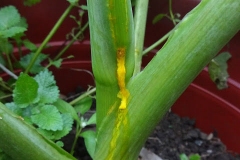Ashitaba is derived from the Japanese words ashita which means tomorrow and ba means leaf, which relates to the plant’s ability to regenerate new leaves after taking cuttings. Angelica is derived from Latin for angel. Keiskei derives from Ito Keisuke, the 19th century Japanese botanist, also referred to as the father of modern Japanese botany. The plant has long been used in Japan as a food that is a healthy addition to the diet and also as a medicine. Recent research has confirmed many of the traditional uses of this plant and it is currently widely available over the Internet as a medicine, food supplement and as seeds for growing the plant.
Ashitaba Facts
| Ashitaba Quick Facts | |
|---|---|
| Name: | Ashitaba |
| Scientific Name: | Angelica keiskei |
| Origin | Japan, where it is found on the Pacific Coast |
| Shapes | Oblong, glabrous, 6–8 mm long, flat |
| Taste | Bitter |
| Health benefits | Support cardiovascular health, Regulate the blood pressure, Slow Down the Aging Process, Increase metabolism, Prevent and cure stomach issues, Improve the central nervous system, Cure Insomnia, Prevent and treat diabetes, Detoxify the blood, Help in premenstrual syndrome, Reduce muscular and joint pain, Overcome the gastrointestinal disorder, Control Cholesterol, Prevent Alzheimer’s disease, Parkinson, and dementia, Natural Solution to Anemia |
| Name | Ashitaba |
|---|---|
| Scientific Name | Angelica keiskei |
| Native | Japan, where it is found on the Pacific Coast.[1] It is endemic to the area of the Bōsō Peninsula, Miura Peninsula, Izu Peninsula, and the Izu Islands |
| Common Names | Asitaba, Longevity herb, Tomorrow’s leaf, Treasure plant |
| Name in Other Languages | Chinese: Tong kuy Dutch: Ashitaba English: Ashitaba Indonesian: Seledri Jepang Japanese: Ashitaba (アシタバ), hachijôsô, Hachijousou (ハチジョウソウ) Javanese: Sledri Jepang Other: Angelica, Ashitaba du Japon, Herbe de la Longevite, Kenso, Leaves of Tomorrow |
| Plant Growth Habit | Herbaceous, biennial to perennial plant |
| Growing Climates | Damp habitats by the sea coast |
| Soil | Grow best in a deep moist fertile soil in dappled shade or full sun |
| Plant Size | 50 to 120 centimeters |
| Root | Roots are stout, conic, or cylindric |
| Rhizomes | Rhizomes thick and short, with few elongate roots |
| Stem | Stems stout, branched above, 80–120 cm long, glabrous |
| Leaf | Leaves radical and lower cauline, usually evergreen, 2–3-ternate-pinnate, obtusely deltoid in outline, 20–60 cm. long, glabrous; leaflets rather thick, usually deeply 2–3 cleft of parted; segments usually ovate, 5–10 cm long, 3–6 cm wide, acute, toothed, with impressed veinlets on upper side; sheaths on the upper part elliptic, inflated |
| Flowering season | June to October |
| Flower | Flowers are hermaphrodite (having both male and female organs) |
| Fruit Shape & Size | Fruit oblong, glabrous, 6–8 mm long, flat; dorsal ribs short and rather thick; lateral ribs winged |
| Propagation | By Seed |
| Taste | Bitter |
| Plant Parts Used | Roots, leaves, stems |
| Available Forms | Infusions, tincture, or poultice |
| Season | July to November |
| Health Benefits |
|
| Other Facts |
|
Plant Description
Ashitaba is an herbaceous, biennial to perennial plant that normally grows about 50 to 120 centimeters tall. The plant is found growing in damp habitats by the sea coast. It grows best in a deep moist fertile soil in dappled shade or full sun. You need to maintain consistent moisture, but avoid overwatering. When the provided soil conditions are favorable, then the ashitaba can grow to a height of four feet. Roots are stout, conic, or cylindrical. Rhizomes are thick and short, with few elongate roots. Stems are stout, branched above and glabrous.
Leaves
Leaves are radical and lower cauline, usually evergreen, 2–3-ternate-pinnate, obtusely deltoid in outline, 20–60 cm. long, glabrous. Leaflets are rather thick, usually deeply 2–3 cleft of parted; segments usually ovate, 5–10 cm long, 3–6 cm wide, acute, toothed, with impressed veinlets on upper side; sheaths on the upper part elliptic, inflated.
Flower
Inflorescence umbels rather numerous; peduncles in upper part; the inner side of rays and pedicels puberulent; rays 10–20; pedicels 20–40; bracteoles of involucel several, linear or slightly broaden at base, caudately elongate, slightly longer or shorter than pedicels; styles short, as long as stylopodium. Flowers are hermaphrodite (having both male and female organs). Flowering normally takes in between June to October.
Fruits
Fertile flower are followed by oblong, glabrous fruit, 6–8 mm long, flat; dorsal ribs short and rather thick; lateral ribs winged.
Health benefits of Ashitaba
Ashitaba has a huge variety of desirable effects on human health. Many studies have been conducted on the health benefits of ashitaba. Here are some of its most valuable capabilities. Ashitaba is known to
1. Support cardiovascular health
It has chalcones which have the incredible ability to decrease and regulate blood pressure. Also, it is anti-clotting agent, which means that it can help to prevent painful and dangerous blood clots. It will increase the good cholesterol levels and it can decrease bad cholesterol and triglyceride levels. It has potassium which helps heart muscle function. It is very important to have good heart health. When you are controlling your cholesterol levels, then this will decrease your risk for stroke, heart attack and heart disease.
2. Regulate the blood pressure
Ashitaba consists of chalcones which have the diuretic function to lower the high blood pressure. It also consists of potassium mineral which controls the heart muscle contraction and the blood pressure.
3. Slow Down the Aging Process
It is impossible to stop the aging process but ashitaba leaves are well known to be the natural solution to slow down the aging process. Ashitaba leaves contain melatonin, one of the powerful antioxidants that contributes in healthy skin and promotes optimal skin cell regenerations to prevent premature aging.
4. Increase metabolism
It is one of the best home remedies for increasing the energy and stimulating metabolism. Also, it will aid in the weight loss. When it is in combination with a healthy diet and regular exercise, then it can remove excess weight. Also, it creates an alkaline pH in the body and this can help to control the appetite. The ashitaba has proteins which can help to build muscle when exercising.
5. Prevent and cure stomach issues
As mentioned previously, it consists of chalcones which are related with the prevention of constipation. Also, it is diuretic, which allows the body to release excess water weight. This can make you to feel better and have better digestion. Also, it can reduce the stomach secretions and it can help with the symptoms of GERD and peptic ulcers. Research carried on animals has shown that higher dose of ashitaba given to them, the less acid was secreted.
6. Improve the central nervous system
When you consume ashitaba, it will encourage the production of nerve growth factor, because it has high levels of Vitamin B12. The nerve growth factor is critical for the survival and maintenance of sympathetic and sensory neurons. When you have healthy neurons, then you will have excellent cognitive function. It is very important to have good central nervous system health, because it controls most functions of the body and mind.
7. Cure Insomnia
There are a lot of factors that could cause someone has problem with their sleeps. Well, whatsoever the reasons are ashitaba leaves could be made into excellent herbal tea for restful sleep. Healthy sleeping habit will improve the brain function and boost the mood.
8. Prevent and treat diabetes
Chalcones contained in ashitaba helps to regulate glucose levels. People who suffer from diabetes can add ashitaba in their diet because it can help reduce insulin by preventing blood sugar spikes. Also, it can increase the insulin sensitivity, lower and stabilize the blood sugar levels. It can reduce blood pressure and enhance the liver and kidney functions.
9. Detoxify the blood
It can prevent and combat anemia due to the high levels of potassium, calcium and iron. Also, it enables the blood to release harmful toxins. It has Vitamin B12 and chlorophyll which allow the blood to flow freely. Also, the ashitaba aids red blood cells and hemoglobin formation. When you are detoxifying the blood, then this will allow the body to be rejuvenated. Blood will transmit any impurities through the body, so it greatly affects your overall health.
10. Help in premenstrual syndrome
Ashitaba consists of chalcones substance which can reduce dysmenorrhea (pain related menstruation). This makes Ashitaba leaves best to consume during premenstrual syndrome to bring the comfort.
11. Reduce muscular and joint pain
The chalcones compound in Ashitaba leaves also has the mechanism in reducing the pain whether for muscular or for joint. It helps to make gout or arthritis disease feeling better.
12. Overcome the gastrointestinal disorder
Ashitaba leaves have an alkalinizing effect which can reduce the acid secretion in the stomach. This can help to overcome gastrointestinal disorder such as gastrointestinal reflux, acute or chronic gastritis, and duodenal ulcer.
13. Control Cholesterol
Research has been conducted to find out a connection between ashitaba leaves and cholesterol management. The result is showing the fact that ashitaba leaves consists of some active compound to help increasing the production of HDL or good cholesterol while potassium will make sure the decrease of LDL or bad cholesterol.
14. Prevent Alzheimer’s disease, Parkinson, and dementia
Ashitaba leaves consist of a substance that can increase the production of nerve growth factor. This protein brings the health benefits of Ashitaba leaves to prevent Alzheimer’s disease, Parkinson, and dementia through its mechanism which can reduce the nerves degeneration. Nerve growth factor maintains the healthy connection between the nerves and the brain
15. Natural Solution to Anemia
Ashitaba leaves are excellent sources of certain minerals, particularly iron. It means ashitaba leaves are solution to those who have problems with anemia. Just a cup of herbal tea made from ashitaba leaves per day will help dealing with the anemia excellently.
Traditional uses and benefits of Ashitaba
- It is said to improve the body’s natural immunity, and to treat a range of ailments including gastro-intestinal tract disorders, acute and chronic gastritis, stomach cancer, duodenal ulcers, gastric atonia, chronic enteritis, carcinomas and melanomas, chronic hepatitis, diabetes and insulin-dependent diabetes, hyperglycemia, asthma, common colds, high blood pressure, anemia, chronic fatigue syndrome, infertility, shoulder stiffness, neurosis, hemorrhoids; to relieve the symptoms of the menopause and PMS.
- It is also said to retard the ageing of the skin and improve its complexion.
- The plant is anti-diabetic, anti-inflammatory, antioxidant, antitumor, blood purifier, diuretic and laxative.
- They have been shown to moderate lipid metabolism and to help prevent adiposity.
- Yellow sap from stems and stalks once used for external treatment of smallpox in Japan.
- Roots traditionally used as diuretic, laxative, analeptic, and galactagogue.
- It is used as remedy for bowel disturbances, dysuria, arthritis, and immune diseases.
- In Chinese medicine, believed to activate Qi and Xue and use in the treatment of menstrual problems.
- Ashitaba is used for “heartburn” (gastro esophageal reflux disease, GERD); stomach ulcers, high blood pressure, high cholesterol, gout, constipation, and hay fever.
- It is also used for cancer, smallpox, fluid retention, blood clots, and food poisoning.
- Women use it to increase the flow of breast milk.
- The juice is used topically to treat a host of skin conditions.
- Juice of the plant is applied to boils, cysts, and pustules to speed healing.
- It is used to clear athlete’s foot fungal infections.
- It is applied to repel insects and to speed healing and prevent infection in insect bites.
- Indeed, applying the juice of the plant is said to cure most skin conditions and to prevent infection in wounds.
- It is used both in chronic and acute skin complaints.
- In form of poultice (fresh smashed plant parts), juice or cosmetic preparations like creams and oils it can be applied on minor wounds, insect bites, acne, rashes, cysts, boils, pustules, smallpox, and on painful muscles and joints to alleviate pain.
- It is traditionally used for stomach, spleen and kidney problems, arthritis, hypertension, diabetes, smallpox, carcinoma, menstrual problems, and edema.
Culinary Uses
- Leaves are consumed raw or cooked.
- Root is cooked or is often pickled.
- Both the fresh leaves and the dried and powdered leaves are used as a health food and supplement.
- In Japan, it is used in the preparation of soba, tempura, socho, tea, ice cream, etc.
- Leaves and stalks are eaten raw, boiled, or deep-fried, or dried and ground for juice, dessert or other value-added products.
- Fresh and raw leaves of ashitaba can be treated like any other leafy green vegetable, so you should add them to smoothies, soups or salads.
- Fresh leaves and leaves stalk both are excellent addiction for salads, sandwiches, or smoothies.
Precautions
- All members of this genus contain furocoumarins, which increase skin sensitivity to sunlight and may cause dermatitis.
- Side effects include complications with the breastfeeding and pregnancy, so women in these conditions should avoid them.
References:
https://pfaf.org/user/Plant.aspx?LatinName=Angelica+keiskei
https://www.cabi.org/isc/datasheet/119401
https://gd.eppo.int/taxon/ANKKE
http://temperate.theferns.info/plant/Angelica+keiskei
http://www.stuartxchange.org/Ashitaba
http://www.theplantlist.org/tpl/record/kew-2639124
https://en.wikipedia.org/wiki/Ashitaba


